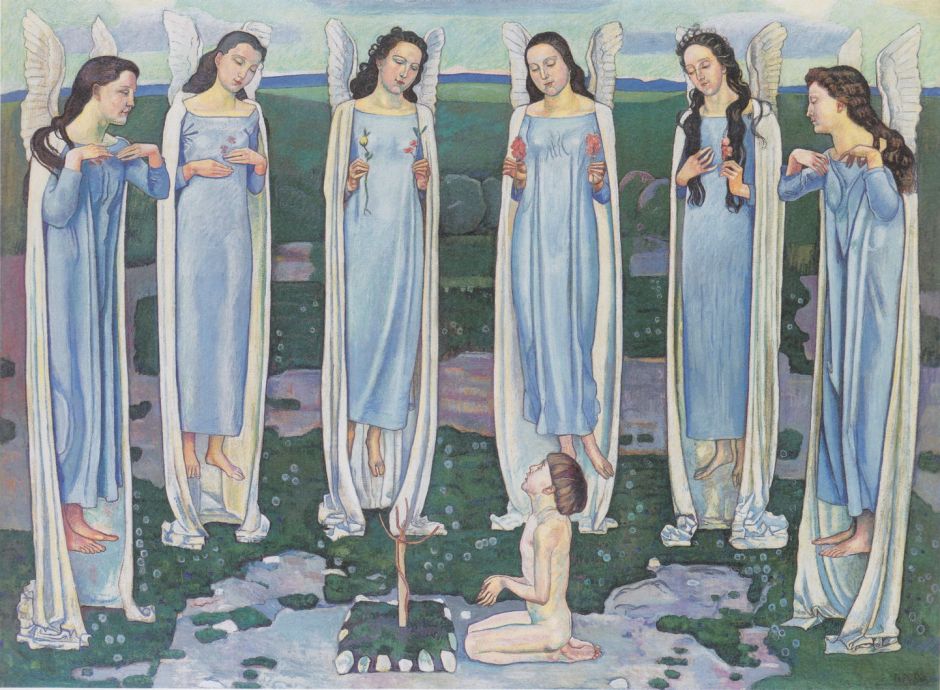In the first years of the twentieth century, Ferdinand Hodler‘s (1853–1918) international reputation became firmly established. He had moved studio within Geneva in 1902, where he started the first version of The Truth. A succession of fine landscapes followed in the summer, when he stayed in Reichenbach: I showed a selection of those in the previous article in this series.
Early the following year (1903), Hodler was in Vienna, where he painted his second version of The Chosen One for Anton Loew, a famous physician whose lavish private clinic cared for the rich and famous, including Gustav Mahler and Ludwig Wittgenstein. Hodler had painted the first version between 1893-94.

The Chosen One (version 2) (1903) shows Hodler’s high Parallelism, with six women dressed identically in light blue gowns forming a rhythmic and near-symmetrical array. Each has angel’s wings, and their feet are raised above the floral alpine meadow. At their centre is a nude boy with a monastic haircut, apparently praying or worshipping by a small and barren sacred tree.
The symmetry is less formal than previously: Hodler has not arranged the angels in matched pairs, and each has slightly different hair, although all are brunettes. Four of them hold flowers, which also add to the compositional informality.
At the end of his seven week stay, Hodler returned to Geneva via Munich, where he officially joined its Secession.

Hodler’s second version of The Truth, painted in 1903, stands in contrast to The Chosen One, with a similar rhythm and symmetry but very different content. As is traditional in art, Truth is a nude woman. She is surrounded by six daemons, who wear black cloths and face away from her.
The traditional basis for depictions of Truth is rooted in Lucian’s description of the Calumny of Apelles, where they represent Ignorance, Envy, Treachery, Deceit, Slander, Suspicion, Fraud, and Conspiracy. While Truth stands in the middle on a small patch of meadow, the figures around her are on hard rock instead.

I don’t know whether Hodler’s View of the Fromberghorn from Reichenbach (1903) was painted from sketches and studies he had made when staying there the previous summer, or he might have returned to the same town in the Bernese Alps in the summer of 1903.
Although this landscape retains the detail of his earlier work, Hodler has narrowed his palette considerably, with most of the painting either being a bright yellow-green, or a darker brown-green, broken only by a few flowers, and distant red rooves.
In early 1904, Hodler was an honorary guest exhibitor at the nineteenth exhibition of the Vienna Secession, with a total of thirty-one works. This marked the attainment of his international reputation, and financial security at last.

Although Hodler stayed in Baden near Vienna during that summer, one of his finest landscapes of 1904 is Lake Thun with Symmetrical Reflection Before Sunrise. This lake, sometimes known by its German name of Thunersee, is also in the Bernese Alps. This introduces into Hodler’s landscapes the same rhythm and symmetry which had come to dominate his figurative paintings.
Early in 1905, Hodler was at last able to visit Italy, in a tour which included Florence, Assisi and Padua.

Hodler’s third version of View into Infinity from 1905 is strongly reminiscent of some of the mountain paintings of Caspar David Friedrich, such as his Wanderer above the Sea of Fog (1818). Standing on a rock pinnacle above Hodler’s sea of fog is a naked young man. Behind him long red mountain ridges pierce through the fog, and the pale lemon sky of dawn has parallel strips of red cloud.

The Grammont (1905) shows this mountain in the Chablais Alps, to the south of the eastern end of Lake Geneva, towards which many of Hodler’s favourite views over that lake were aimed. Again he has a very limited palette; the lake itself reminds me of Gustav Klimt’s wonderful paintings of Attersee from 1900, although Hodler’s darker blue ripples quickly vanish as the lake recedes from the viewer.

Song From Afar (1906) returns to Hodler’s long-running series of paintings showing women walking in alpine meadows. On this occasion, she holds out her arms almost like The Truth. She may hear a song coming from afar, but her mouth is closed and she is not singing, as she walks down from the rolling green pasture.

Hodler appears to have worked on The Sacred Hour over a protracted period, from about 1901 or 1902 to 1911 or even 1916. Here are two women, establishing another rhythm with its pervasive yet informal symmetry. Both were apparently painted from the same model, but the head of the woman at the left looks older and more masculine.
They are dressed in blue eurhythmic dance costumes, referring to rhythmic motion. Around them are swirls of poppy flowers, forming arcs and circles which also show symmetry.

Tree on Lake Brienz from Bödeli (1906) shows the lake adjacent to Lake Thun in the Bernese Alps, viewed from the spit of land which divides the two lakes. On this same spit is the popular resort of Interlaken, named from its position between the lakes.
The following year, Hodler was to return to painting large commissioned murals.
Reference
Hans-Peter Wipplinger (ed) (2017) Ferdinand Hodler, Elective Affinities from Klimt to Schiele, Leopold Museum / Walther König. ISBN 978 3 96098 220 3.

